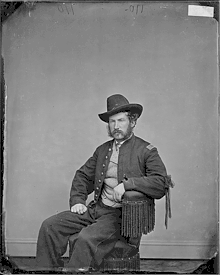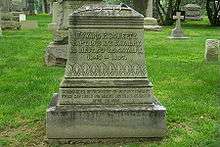Edward P. Doherty
Edward Paul Doherty (September 26, 1838 – April 3, 1897) was an Irish-Canadian-American U.S. Civil War officer who formed and led the detachment of soldiers that captured and killed John Wilkes Booth, the assassin of United States President Abraham Lincoln, in a Virginia barn on April 26, 1865, twelve days after Lincoln was fatally shot.

Early life and service in the American Civil War
Doherty was born September 26, 1838 in Wickham, Canada East, to immigrant parents from Sligo, Ireland.[1] His birth year has long been incorrectly believed to have been 1840; however, it was clearly recorded as 1838 in Wickham's parish records.[2]
He came to New York in 1860 where he was living when the American Civil War broke out. He enlisted in a 90-day militia unit and was assigned as a Private to Company A of the 71st New York Volunteers on April 20, 1861. Assigned to Colonel Ambrose Burnside's 2nd Brigade of Brigadier General David Hunter's 2nd Division, he was captured by the Confederates during the First Battle of Bull Run, the first major land battle of the American Civil War, fought on July 21, 1861, near Manassas, Virginia. While a prisoner, he made a daring escape. Ultimately, the 71st Regiment, along with Doherty, mustered out on August 9, 1861.
Doherty went on to become a Captain in the Corcoran Legion, formed by fellow prisoner at the First Battle of Bull Run, Irish-American General Michael Corcoran, who was a close confidant of Abraham Lincoln. Doherty served for two years, before being appointed First Lieutenant in the 16th New York Cavalry on September 12, 1863. The regiment was assigned to the defense of Washington, D.C. for the duration of the war, where Doherty distinguished himself as an officer.
Pursuit and capture of John Wilkes Booth
On April 24, 1865, 10 days after the assassination of Abraham Lincoln, Acting Assistant Adjunct General A. R. Sewell sent an order to the Commander of the 16th New York Cavalry, Captain Joseph Schneider, to assign a reliable and discreet commissioned officer with 25 men to report to Colonel L. C. Baker at once. Captain Schneider then chose Lieutenant Edward Doherty to lead the group[3] and Doherty reported to Colonel Lafayette C. Baker, Agent of the Department of War. Doherty and his men were to hunt down John Wilkes Booth and any co-conspirators. Two days later, the men of the 16th NY Cavalry Regiment, accompanied by two detectives of the intelligence service, Luther Baker, cousin of Lafayette C. Baker, and Everton J. Conger, caught up with Booth and his accomplice David E. Herold in a tobacco barn near Port Royal, Virginia owned by Richard H. Garrett. With the barn surrounded, Doherty called upon Booth to surrender, but he refused and threatened to shoot anyone who entered. His accomplice relented and as he surrendered to Doherty, Sergeant Boston Corbett fatally shot Booth through a crack in the side of the barn, as the assassin had been aiming to fire at either Doherty or Herold. Doherty stated that "the bullet struck Booth in the back of the head, about an inch below the spot where his shot had entered the head of Mr. Lincoln." Booth's spinal cord was severed, and he died two hours later.[4] Doherty and the men of his regiment returned to Washington, D.C. on April 27, 1865 with Booth's body.
Military career after Abraham Lincoln's assassination
For his service in the capture of Lincoln's assassin, Doherty was promoted to Captain and given a US$5,250 reward, while remaining in the cavalry. The 16th New York Cavalry was merged with the 13th New York Cavalry forming the 3rd Regiment New York Provisional Cavalry on June 23, 1865, which was then mustered out on September 21, 1865. Seven months later, Doherty joined the regular cavalry and was assigned to the 5th Regular Cavalry as a Second Lieutenant on April 19, 1866. He was promoted to First Lieutenant on March 1, 1867 in the 1st Cavalry and remained in the regular army until mustering out on December 27, 1870. During his last years in the military, he served some time under General George Meade as Inspector General of the Department of Georgia, which had been created by the military in 1865 as part of the Third Military District during the post-war Reconstruction period.
Post-military life and death

In 1871, after resigning from the United States Army, Doherty went into business in New Orleans. Having returned to New York City in 1886, he was appointed Inspector of Street Pavings, a position which he held from 1888 until his death on the morning of April 3, 1897. He was Past Commander of Veteran Post Number 436, G. A. R.; as well as a member of the 71st Regiment Veterans and also of the Press Veterans. He served twice as Grand Marshal in Memorial Day celebrations. Doherty succumbed to heart disease, dying in his home at 533 West 144th Street, the funeral was held on April 5, 1897 at the Church of St. Charles Boromeo church, then located at 132nd Street and Seventh Avenue. He is buried in Section 1 of Arlington National Cemetery in Washington, D.C.. His tombstone reads: "Commanded detachment of 16th N.Y. Cavalry which captured President Lincoln's assassin April 26, 1865."
See also
- Enlisted Canadians in the American Civil War
- Cavalry in the American Civil War
- Abraham Lincoln assassination
- John Wilkes Booth
References
- Parker, Alan (May 4, 2015). "The Canadian Who Captured Abraham Lincoln's Assassin". Toronto Sun. Retrieved October 8, 2015.
- "Québec, registres paroissiaux catholiques, 1621-1979," database with images, FamilySearch (https://familysearch.org/pal:/MM9.3.1/TH-1942-28000-5937-33?cc=1321742 : accessed 18 December 2015), Drummondville > Saint-Frédéric-de-Drummondville > Index 1816-1876 Baptêmes, mariages, sépultures 1816-1844 > image 444 of 613; Catholic Church parishes, Quebec.
- <Official records for the Union And Confederate Armies, 1861-1865, Series I: Formal reports... Chapter LVIIL pages 1317-1318
- "The Death of John Wilkes Booth, 1865". Eyewitness to History/Ibis Communications. Retrieved August 16, 2012. (Quoting Lieutenant Edward Doherty, officer in charge of the soldiers who captured Booth)
| Wikimedia Commons has media related to Edward P. Doherty. |
- "The Battle of Bull Run; The 71st New York Regiment; Interesting statement of Edward P. Doherty", The New York Times, August 6, 1861.
- Doherty, Edward P., Pursuit and Death of John Wilkes Booth, Century Magazine XXXIX (January, 1890).
- "The Death of John Wilkes Booth", Washington Exchange, 1887.
- Doherty's report to the War Department recounting Booth's capture, dated April 29, 1865.
- "E. P. Doherty passes away", The New York Times, April 4, 1897 (PDF).
- Military record, as well as Doherty's report and the New York Times article in text format.
- Short biography of Lieutenant Doherty with more details on his military record.
- Canadians in the American Civil War at the Wayback Machine (archived October 26, 2009)
- Five Letters of Edward P. Doherty